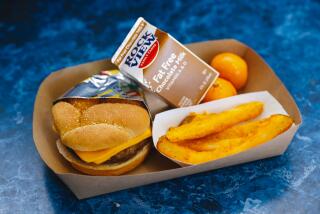The new school food -- fewer chips, more carrots?
- Share via
Whole-grain crackers, low-fat yogurt and fruit could become the school snacks of the future, driving out fattening fancies such as cola and fried chips.
The Institute of Medicine on Wednesday recommended new standards for school snacks and foods that would sharply limit calories, fat and sugar and encourage more nutritious eating.
Concerned about the rise of obesity among young people, Congress asked the institute to develop the standards. Legislators now will consider them, as will state and local school officials.
“Making sure that all foods and drinks available in schools meet nutrition standards is one more way schools can help children establish lifelong healthy eating habits,” said Virginia A. Stallings, head of the committee that prepared the report, and director of the nutrition center at Children’s Hospital of Philadelphia.
“Foods and beverages should not be used to reward or to discipline for academic activities or behavior,” Stallings said.
Food sold in school cafeterias under federally assisted lunch programs already must meet nutritional standards. The institute’s recommendations cover items considered competitive with those foods. Examples include snacks in vending machines and other food and drinks sold at school but not under the federal program.
Selling these foods is a moneymaker in some communities. Janey Thornton, president of the School Nutrition Assn., which represents school food service directors, said she expects complaints about losing this source of money if the recommendations are adopted. “Shame on us if we try to balance the school budget based on the nutritional health of kids,” she said.
The standards would not apply to bag lunches that students bring from home.
Sen. Tom Harkin (D-Iowa), chairman of the Senate Agriculture, Nutrition and Forestry Committee, said the recommendations “offer a tool kit for local, state and federal policymakers who already know that we need to do more much more -- to promote sound child nutrition and prevent childhood obesity.”
Thornton, who is child nutrition director for the Hardin County School District in Kentucky, said she thinks the report does not go far enough because there is no system for enforcement. “We would like to see national standards for [school] food and beverages” that the Agriculture Department could enforce, she said.
But the Center for Consumer Freedom, which describes itself as representing restaurants, food companies and individuals, said it worried that the report could lead to a government “no child with a fat behind” program. The growing rate of obesity is caused by lack of physical activity rather than overeating, according to the group.
The report lists a first tier of foods that would be allowed at all grade levels during the school day and during after-school activities. These foods would have to provide at least one serving of fruits, vegetables, whole grains or nonfat or low-fat dairy. There would be limits for fat, sugar and salt.
Examples are whole fruit; raisins; carrot sticks; whole-grain, low-sugar cereals; some multigrain tortilla chips; some granola bars; and nonfat yogurt with no more than 30 grams of added sugars. Drinks would be limited to plain water, skim or 1% milk, soy beverages and 100% fruit or vegetable juice.
A second tier of foods would be available only to high school students and only after school hours.
These foods would be limited in calories, salt, sugar and fat; drinks could have just five or fewer calories per portion and no caffeine. Examples include single servings of baked potato chips, low-sodium whole-wheat crackers, graham crackers, pretzels, caffeine-free diet soda and seltzer water.
The report can be accessed online at www.nationalacademies.org/iom.
More to Read
Sign up for Essential California
The most important California stories and recommendations in your inbox every morning.
You may occasionally receive promotional content from the Los Angeles Times.










